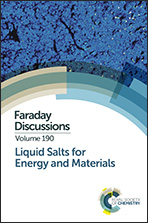Molten salt CO2 capture and electro-transformation (MSCC-ET) into capacitive carbon at medium temperature: effect of the electrolyte composition
Abstract
Electrochemical transformation of CO2 into functional materials or fuels (i.e., carbon, CO) in high temperature molten salts has been demonstrated as a promising way of carbon capture, utilisation and storage (CCUS) in recent years. In a view of continuous operation, the electrolysis process should match very well with the CO2 absorption kinetics. At the same time, in consideration of the energy efficiency, a molten salt electrochemical cell running at lower temperature is more beneficial to a process powered by the fluctuating renewable electricity from solar/wind farms. Ternary carbonates (Li : Na : K = 43.5 : 31.5 : 25.0) and binary chlorides (Li : K = 58.5 : 41.5), two typical kinds of eutectic melt with low melting points and a wide electrochemical potential window, could be the ideal supporting electrolyte for the molten salt CO2 capture and electro-transformation (MSCC-ET) process. In this work, the CO2 absorption behaviour in Li2O/CaO containing carbonates and chlorides were investigated on a home-made gas absorption testing system. The electrode processes as well as the morphology and properties of carbon obtained in different salts are compared to each other. It was found that the composition of molten salts significantly affects the absorption of CO2, electrode processes and performance of the product. Furthermore, the relationship between the absorption and electro-transformation kinetics are discussed based on the findings.
- This article is part of the themed collection: Liquid Salts for Energy and Materials

 Please wait while we load your content...
Please wait while we load your content...